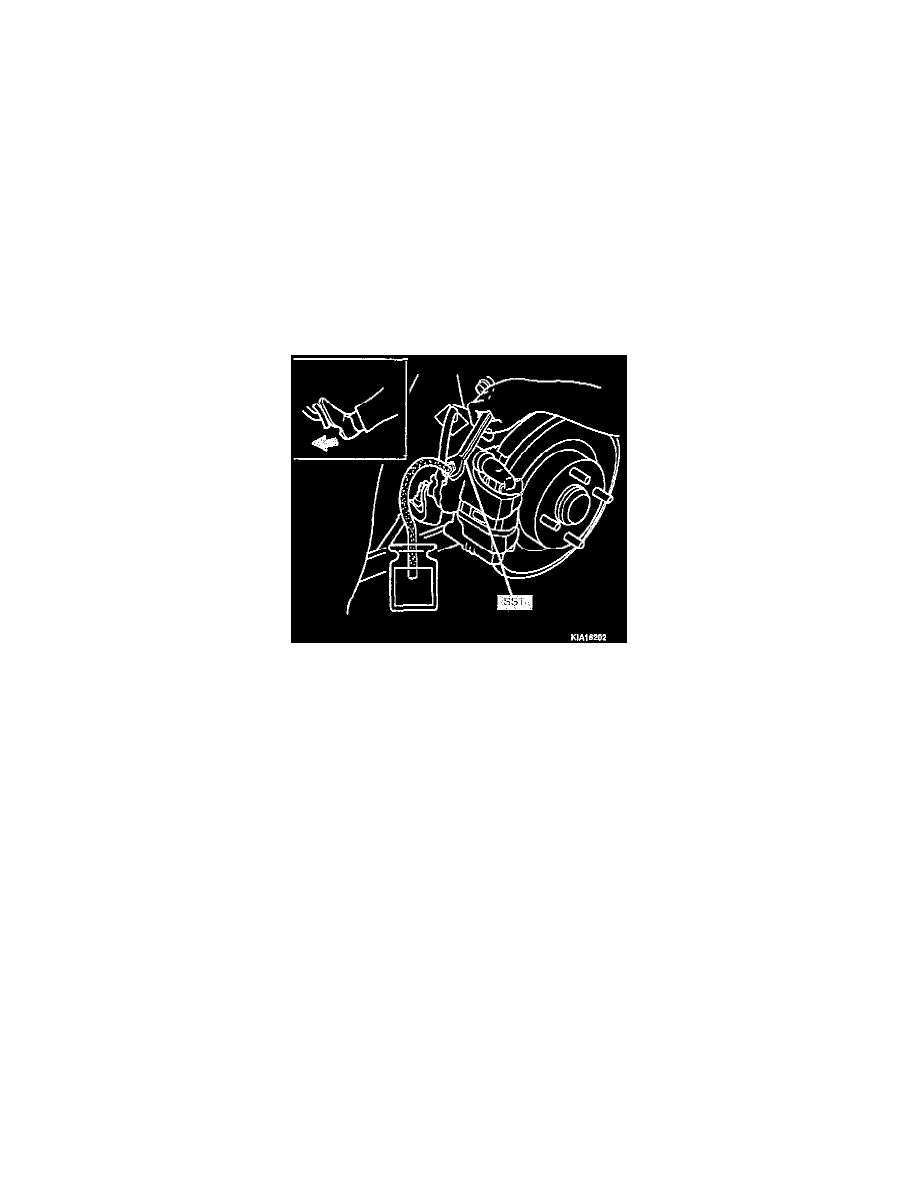Sephia GS Sedan L4-1.8L (1997)

-
THE PUMP IN THE ABS, WHEN OPERATING, PRODUCES HIGH BRAKE FLUID PRESSURE THROUGHOUT THE BRAKE SYSTEM.
IT IS IMPORTANT THAT ALL FLUID CONNECTORS BE SECURE BEFORE ALLOWING THE PUMP MOTOR TO OPERATE. THIS
PRESSURE SUBSIDES QUICKLY WHEN THE PUMP MOTOR SHUTS OFF AND IS OF NO CONCERN DURING MOST ABS
SERVICING. BE CAUTIOUS, HOWEVER, WHEN BREAKING A FLUID CONNECTION IMMEDIATELY AFTER THE PUMP MOTOR
HAS OPERATED. RESIDUAL PRESSURE MAY BE PRESENT.
-
BRAKE FLUID CONTAINS POLYALKALENE GLYCOL ETHERS. AVOID CONTACT WITH EYES. WASH HANDS THOROUGHLY
AFTER HANDLING. IF BRAKE FLUID CONTACTS EYES, FLUSH WITH RUNNING WATER FOR 15 MINUTES. GET MEDICAL
ATTENTION IF IRRITATION PERSISTS. IF TAKEN INTERNALLY, DRINK WATER AND INDUCE VOMITING. GET MEDICAL
ATTENTION IMMEDIATELY.
CAUTION:
-
When any part of the hydraulic brake system has been disconnected for repair or replacement, air may get into the lines and cause spongy, unsafe
pedal action. This requires the bleeding of the brake system to ensure that all air is expelled from the brake cylinders and lines. The brake system
can be bled manually or with pressure-bleeding equipment, such as a brake bleeder. Pressure bleeding is the preferred method.
-
Bleed one wheel at a time. Start the bleeding at the right rear wheel and then the left rear wheel. Proceed to bleed the front brakes, starting with the
right front brake. Finish bleeding at the left front brake. Keep the master cylinder reservoir filled with SAE J1703 DOT 3 or DOT 4 brake fluid.
-
Never reuse brake fluid that has been drained from the system.
-
Do not allow the reservoir to run dry during the bleeding operation. Keep the master cylinder reservoir filled with the specified brake fluid.
1. On the master cylinder, loosen one of the brake line fittings using a flare nut wrench.
2. Wrap a shop cloth around the tubing below the fitting to absorb escaping brake fluid.
3. Have an assistant slowly push the brake pedal down to the floor. This will force air trapped in the master cylinder to escape at the fitting.
4. Hold the pedal down and tighten the fitting. Release the brake pedal. Do not release the brake pedal until the fitting is tightened or air will re-enter
the master cylinder.
5. Continue this procedure until air ceases to escape at the fitting. Repeat for remaining fittings.
6. Place a box wrench on the bleeder fitting of the brake wheel cylinder. Attach a rubber drain tube to the bleeder fitting, making sure the end of the
tube fits snugly around the bleeder fitting.
7. Submerge the free end of the tube in a container partially filled with clean brake fluid. Loosen the bleeder fitting.
8. Slowly push the brake pedal all the way down. Close the bleeder fitting and then return the pedal to the fully released position. Repeat this
operation until air bubbles no longer appear at the submerged end of the bleeder tube.
9. When the fluid is completely free of air bubbles, close the bleeder fitting and remove the bleeder tube.
10. Repeat this procedure at the remaining brake cylinders. Refill the master cylinder reservoir after each wheel cylinder is bled.
11. When the bleeding operation is complete, fill the master cylinder to the MAX level line on the master cylinder reservoir. Clean and install the
master cylinder reservoir cap.
